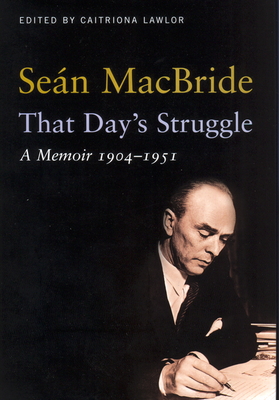That Day's Struggle: a memoir
Roy Johnston reviews That Day's Struggle: a memoir 1904 - 1951, by Sean MacBride, edited by Caitriona Lalor, Currach Press, ISBN 1-85607-929-5, £17.50/€24.99

IN THE period covered by this memoir I had encountered MacBride, viewed from below, during the flowering of Clann na Poblachta, in the context of the inter-party government.
I had been aware of some aspects of his earlier roles, through contact with George Gilmore, who was convinced that he was in line for the job of 'quisling' taoiseach had the Germans landed in 1941, as they might have done, given his leading role in the pre-war German-oriented IRA.
According to his memoir, MacBride became 'caretaker' IRA chief of staff in 1936, following the arrest of Moss Twomey. He presided over a movement in which a militarist element under Sean Russell was planning a war on England, and on the fringe of which a political left-republican element led by Peadar O'Donnell and George Gilmore were attempting to take up social issues.
In this context the latter had been supportive of the 1934 'Outdoor Relief' agitations in Belfast, building bridges into Protestant working-class culture. They had succeeded in bringing a contingent from the Shankill Road to commemorate Wolfe Tone at Bodenstown.
Fintan O'Toole, in his Irish Times column published on 28 February 2006, outdoor relief, mentions this episode, suggesting however that the Shankill contingent was the victim of Catholic-sectarian attacks from the IRA at Bodenstown, and that this was under MacBride's leadership.
I had been aware of the 'Shankill at Bodenstown' episode in the context of the folk-memory of the Republican Congress, to which we in the student left of the late 1940s looked for inspiration, but was not aware of any sectarian attack.
Had this really happened, and been conveniently forgotten? If it did happen for real, and was not a case of 'creative reporting' by a hostile press, was MacBride chief of staff at the time? The dates require some stretching for Fintan O'Toole's version to be valid, and I hope this can eventually be cleared up by historians.
There is alas nothing about it in the MacBride memoir, which suggests that in his 1936 leading role he was aspiring to take up the opportunities to 'go political' presented by the 1937 Constitution of de Valera.
On the positive side, we get some insights into the details of what went on during the Treaty negotiations, with the delegation split between two locations, also on the role of Collins during the truce, when arms deals were attempted.
He is critical of the Church for being, in effect, a British agent. He finds de Valera's non-participation in the Treaty talks incomprehensible, but does not hold him responsible for the Civil War. MacBride was in jail for the Civil War and he describes with relish an abortive escape attempt, involving a tunnel from Mountjoy.
The aftermath of the conflict involved prisoners being moved. It was in this context that he escaped and spent some time on the run, during which he again became active in the IRA, at the level of arranging false passports for de Valera to visit Rome in 1924-5 and lobby the Vatican, along with Archbishop Mannix from Australia. It was during this episode de Valera developed his approach to founding Fianna Fail in 1926.
The death on hunger-strike of Sean McCaughey in May 1946 was the trigger for the founding of Clann na Poblachta, along with Con Lehane, Noel Hartnett and others.
MacBride's account includes the steps leading to the 1948 inter-party government. The hurdle of association with Fine Gael was dealt with by the selection of Costello as leader rather than the dreaded Mulcahy, while MacBride stood over Browne for Health, and got his way. However, he felt that Browne let him down by failing to attend cabinet meetings.
The issue of his relationship with Browne, and Browne's role, is treated somewhat subjectively. There is no mention of any role for the Archbishop and he blames Browne for threatening to bring down the government.
It would be of interest to compare the memoirs of both men and relate them to the contemporary records, and to the memoirs of others who observed the events.
This book is worth a read for the insights it gives into the complexities of the process of superposing a constructive political culture on people steeped in IRA militarism and we owe a debt of gratitude to Catriona Lalor, Sean MacBride's literary executor and secretary from 1977 up to his death in 1988.
It is however a long way from being a balanced historical analysis; one should not expect this of a memoir.
I look forward to seeing the next volume, which will no doubt deal with his developing international role subsequent to 1951, in which context I came to know him directly via his work with the United Nations.
Connolly Association, c/o RMT, Unity House, 39 Chalton Street, London, NW1 1JD
Copyright © 2006 Roy Johnston

